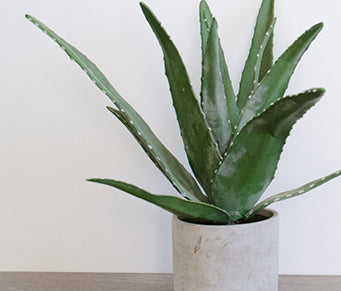From glossy green vines cascading down your window sill to a spray of fresh blooms to brighten your bedside, it’s no secret that plants can transform a space with their free-form beauty. But aesthetics aside, did you know certain varieties are also scientifically proven to help you get a better night’s rest?
Because we’re obsessed with discovering all the ways to improve sleep, we scoured the studies on the subject and picked our six favorite plants, based on looks, ease of care and sleep-promoting benefits.

Lavender
As we head into the height of lavender season, there’s no better time to snag a bouquet of this purple wonder plant. Numerous studies have shown that the scent of lavender eases anxiety and insomnia by lowering heart rate and blood pressure, putting you in the perfect relaxed state for sleep. Plus, you’re more likely to wake up feeling refreshed and energized. To get the most out of your lavender, dry it while it’s still fresh and keep a handful of the buds in a vase on your bedside table.

Aloe Vera
A study by NASA revealed that certain plants have the power to purify the air in our homes—and the easy-to-care for, completely adorable aloe vera plant is on that list. Dubbed the “Plant of Immortality” by the ancient Egyptians because of its resilience (hint: no green thumb required to keep it alive), aloe vera gives off plenty of oxygen as well as lowers carbon dioxide levels at night. It also helps clear chemicals like formaldehyde and benzene, improving the overall quality of the air and your zzzs.

Areca Palm
Its lush, dramatic looks and calming, tropical vibe make this sun-lover one of the more in-demand houseplants. Not only does it help ease colds and sinus problems by releasing moisture into the atmosphere—it’s essentially an all-natural humidifier—it creates a show-stopping focal point in your bedroom, ranging on average between 4 and 6 feet high. Talk about taking your sleep quality to new heights.

English Ivy
Ideal for asthma sufferers, English Ivy, which also made NASA’s list, helps you breathe easier at night thanks to its proven mold-destroying powers. According to the American College of Allergy, Asthma & Immunology, this cascading beauty was shown to remove 78% of airborne mold in just 12 hours. Because it can be toxic to children and pets, make sure to keep your ivy plant out of reach, either by hanging it from a ceiling hook or placing it on a high shelf.

Gardenia
Next time you’re thinking of reaching for the sleeping pills, why not try a gardenia plant instead? Prized for its heady, hypnotic fragrance and exotic white blooms, the gardenia is said to improve your mood, and promote sleep in the process. In fact, according to a German study, the compounds responsible for the gardenia’s intoxicating scent could be as effective in lulling you to sleep as a valium. To keep your gardenia looking its best, place it in bright, indirect sunlight and make sure the soil is moist but not soggy.

Golden Pathos
Another one of our favorites from NASA’s list, golden pothos thrives in darker conditions and requires minimal care, so it would do well in a bedroom with limited light. Its glossy, tumbling fronds not only look gorgeous, they simultaneously remove harmful toxins, like benzene, formaldehyde and carbon monoxide, from the air. Its purifying properties work even in unventilated conditions, making it a great choice for cozy winter nights when you want to keep the windows tightly closed.
Whether you choose to go with just one variety or transform your bedroom into a lush oasis, these plants are sure to help you drift off into dreamland in style. All it takes is a bit of love and care. Now let’s get growing!



0 comments